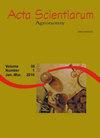Yield prediction in banana (Musa sp.) using STELLA model
IF 1.2
4区 农林科学
Q3 AGRONOMY
引用次数: 0
Abstract
To overcome the challenges encountered in banana cultivation, such as the high cost of production due to high water consumption by the banana plant, efficient management practices are being adopted. The use of agricultural forecasting techniques is an alternative that has been gaining attention in rural areas. One way to manage and improve agricultural productivity is the use of technologies that allow the monitoring of production. The implementation of computational tools as software to aid processes, such as irrigation management, is gradually taking up space in the agricultural sector. In this light, herein, the present study aimed to develop a model using STELLA 8.0 software to estimate the growth and productivity of irrigated banana (Musa sp.). For this, the physiological processes and water demand were calculated using reference evapotranspiration (ET0) and culture evapotranspiration (ETc) in the first banana cycle for the climatic conditions of the Jaíba Project (Jaíba, Minas Gerais State, Brazil). The data of the climatic conditions were obtained from the National Institute of Meteorology. It was verified that the average monthly ET0 was 5.78 mm day-1. In addition, the water requirement of the plant corresponded to a blade equivalent to 65% of ET0. The verified productivity was 8.93 t ha-1, which is considered adequate for the simulated conditions. The model responded efficiently to the proposed application and was characterized as a prognostic tool of reality through simplified representation.利用STELLA模型预测香蕉(Musa sp.)产量
为了克服香蕉种植中遇到的挑战,例如由于香蕉植物耗水量大而造成的生产成本高,正在采取有效的管理做法。在农村地区,利用农业预报技术是一种日益受到重视的备选办法。管理和提高农业生产力的一种方法是使用能够监测生产的技术。采用计算工具作为辅助诸如灌溉管理等过程的软件,正逐渐在农业部门占据一席之地。有鉴于此,本研究旨在利用STELLA 8.0软件建立一个模型来估计灌溉香蕉(Musa sp.)的生长和生产力。为此,利用Jaíba项目(Jaíba,巴西米纳斯吉拉斯州)气候条件下第一个香蕉周期的参考蒸散量(ET0)和培养蒸散量(ETc)计算了生理过程和需水量。气候条件的数据来自国家气象研究所。验证了月平均ET0为5.78 mm day-1。此外,植物的需水量对应于叶片当量的65%。验证的产能为8.93 t hm -1,对于模拟条件来说是足够的。该模型对提出的应用作出了有效的响应,并通过简化的表示将其描述为现实的预测工具。
本文章由计算机程序翻译,如有差异,请以英文原文为准。
求助全文
约1分钟内获得全文
求助全文
来源期刊

Acta Scientiarum. Agronomy.
Agricultural and Biological Sciences-Agronomy and Crop Science
CiteScore
2.40
自引率
0.00%
发文量
45
审稿时长
>12 weeks
期刊介绍:
The journal publishes original articles in all areas of Agronomy, including soil sciences, agricultural entomology, soil fertility and manuring, soil physics, physiology of cultivated plants, phytopathology, phyto-health, phytotechny, genesis, morphology and soil classification, management and conservation of soil, integrated management of plant pests, vegetal improvement, agricultural microbiology, agricultural parasitology, production and processing of seeds.
 求助内容:
求助内容: 应助结果提醒方式:
应助结果提醒方式:


